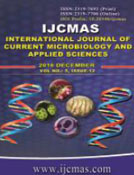


 National Academy of Agricultural Sciences (NAAS)
National Academy of Agricultural Sciences (NAAS)

|
PRINT ISSN : 2319-7692
Online ISSN : 2319-7706 Issues : 12 per year Publisher : Excellent Publishers Email : editorijcmas@gmail.com / submit@ijcmas.com Editor-in-chief: Dr.M.Prakash Index Copernicus ICV 2018: 95.39 NAAS RATING 2020: 5.38 |
Antibiotic resistance is a worldwide health problem increasing with developing resistant strains. Therefore, there is a growing need to develop a simple, economic, commercially viable as well as the eco-friendly clean route for the synthesis of nanoparticles that can be used as nanodrug against multidrug resistance pathogens. To achieve this goal, peel extract of Citrus sinensis was implemented for nanoparticles synthesis in this study. The successful formation of silver nanoparticles has been monitored by ultraviolet–visible spectroscopy. Biosynthesized nanoparticles were characterized using transmission electron microscopy and X-ray diffraction spectra respectively. Seventy-two clinical Salmonella sp. isolates were isolated and fluoroquinolone resistance mechanisms of five isolates were studied. Cell wall modification, over expression of efflux pump and gene mutation in gyrA and/or parC genes were revealed. In vitro bio Ag-NPs showed effective bactericidal activity against forty-five Salmonella sp. with 40 μg/mlas minimum inhibitory concentration. Growth kinetics of Salmonella typhimurium showed a reduction in the number of viable cells after 24 h. According to transmission electron microscope, cell wall was damaged by pit formation. A membrane with such morphology exhibited a significant (p< 0.05) increase in permeability with increasing leakage of cytoplasm constitutes as proteins and nucleic acid.
 |
 |
 |
 |
 |